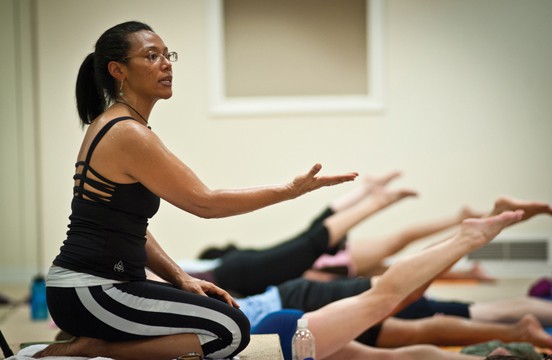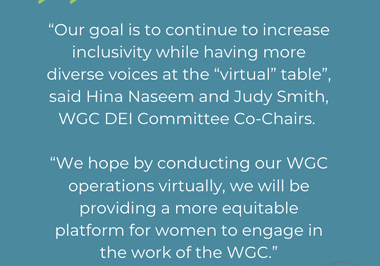STORY BY Kim Polyniak
The evening hours tick away as more than a dozen students gather inside a room in Columbia. A large red rose adorns the wall above. “Let’s start in Adho Mukha Svanasana, please,” the teacher, Cheryl Catranbone says.
The students move into Downward- Facing Dog. Their bodies shape into upside down V’s, with hands and feet flattened to the ground, hips raised to the ceiling. Student Chris McCloskey says this is one of her favorite poses. Throughout class, she and her fellow students move through different positions — Plank, with bodies in a stiff push-up position, Cobra with curved spines and eyes raised to the sky. The students bend, stretch, breathe.
Catranbone is instructing the students at The Yoga Center of Columbia in an intermediate/advanced yoga class. Yoga, a physical and mental discipline that seeks to connect the mind, body and spirit is an ancient tradition – some say more than 5,000 years old – that people continue to embrace for a variety of reasons, including fitness, wellness and relaxation.
“You can find yoga outside in parks, at fitness clubs and in people’s homes and small studios,” says Stacy Wig, Group Fitness Department head at Life Time Fitness in Columbia. “People are realizing it’s not just an integral part of a fitness regimen, but a way of life.” In 2008, Yoga Journal reported that almost 16 million – about seven percent – of U.S. adults practiced yoga. But because of its exploding popularity, estimates today are much higher. Celebrities like Madonna and Jennifer  Aniston and athletes like Olympic gold medal winners Serena Williams and Misty May-Treanor are said to practice yoga.
Aniston and athletes like Olympic gold medal winners Serena Williams and Misty May-Treanor are said to practice yoga.
The Indian sage Patañjali outlined the Eight Limbs of Yoga – limbs that include moral values, meditation, withdrawl of the senses and even union with the divine – around 2,000 years ago in his text “Yoga Sutras.” While embracing all these limbs can be “a pathway to going deeper into your awakened self,” according to Kathy Donnelly, owner of The Yoga Center of Columbia, most people who practice yoga today are familiar only with the third and fourth limbs, which focus on postures (asanas) and breathing techniques (pranayama).
The most familiar type of yoga in the west is Hatha, a term that encompasses different forms that combine physical movements and postures with breath work. While Hatha’s subsets vary in how poses are done, and in what order, the goal of most styles, says Anne Lamberty, an instructor at Life Time Fitness, “is to bring you more in touch with yourself, to bring you awareness.”
Hatha yoga includes several styles:
Iyengar yoga, founded by B.K.S. Iyengar, born in 1918, focuses on precise body alignment and often employs such props as straps, blocks and blankets.The Yoga Center of Columbia features Iyengar-style “alignment-based” yoga at levels ranging from chair yoga to advanced. Alignment, says Donnelly, helps the body to “open and strengthen,” introducing both balance and flexibility. This style of yoga, she says, “addresses everyone down the line, because the intention is to align the body as well as it can, whatever condition you are in.”
Yoga helped Chris McCloskey, a student at The Yoga Center, not only physically, but spiritually. After her mother had a stroke, McCloskey says, yoga “helped me to be a calm and uplifting presence for my Mom.” At the same time, she says, “it helps me take care of my body, mind and spirit.”
Kundalini yoga is considered by many to be a style that combines the physical with the spiritual. While it’s based on physical poses and breathing exercises, the style also includes meditation and chanting mantras. Kundalini is believed to awaken energy at the base of the spine and push it upward. The emphasis, says Joseph Roberson, an instructor at WisdomWell in Columbia, “is on physiology – on your glands, on the functioning of your body’s systems, on your organs – rather than just your ability to stand on one leg.”
Vinyasa, also known as “flow” yoga can be vigorous. It’s dynamic and involves a lot of movement, “more like exercise,” says Roberson. This style incorporates breath with movement in a flowing practice. The poses and sequences don’t follow a prescribed order, but the idea is to unite breath and movement for an energetic workout.
Ashtanga, which means “eight limbs” in Sanskrit, includes a vinyasa component, similarly combining movement with breath. But the style features a set series of challenging poses performed in a specific sequence. Lynn Drucker practices Ashtanga at Life Time Fitness and reports that it has helped increase her flexibility. “The breathing, the meditation, the focus, really help in daily life,” she says, along with improving her fitness and strength.
breathing, the meditation, the focus, really help in daily life,” she says, along with improving her fitness and strength.
For those who really want to sweat, there’s Bikram yoga. Bikram Choudhury branded and franchised his eponymous style in the 1990s. It’s practiced in a room heated to 105 degrees Fahrenheit, with a 40 percent humidity level. The heat, says Kat Kelley- Chung, owner of Bikram Yoga Columbia, warms your muscles, preparing your body for the postures. “And then it makes you sweat,” she adds. “There’s a lot of benefit to the sweating.” The style involves a series of 26 postures, each done twice, along with two specific breathing exercises.
Rhonda Gaines says she “could be an advertisement for Bikram yoga.” The practice, she says, “is very grounding – not to mention that it keeps the fluid moving, keeps you in shape.”
So how can people find the right yoga style for them? Try and try again. “If whatever yoga you tried doesn’t resonate with you, try another – either try another style or try another teacher,” says Kelley-Chung.
No matter the type, most agree that yoga is good for you. Benefits often associated with the practice include improving strength, flexibility, range of motion and balance; helping with posture and alignment; relieving pain; aiding sleep; boosting energy; and lowering blood pressure. People often seek out yoga to reduce stress. Yoga can also be a great way to relax, says Michael Silverman, M.D., cardiologist and chairman of the Department of Medicine at Howard County General Hospital. “You can turn the rest of the world off.”
But like any physical activity, yoga can lead to injuries if not practiced properly. While yoga isn’t generally associated with bodily harm, The Yoga Center’s Donnelly says, you can become injured “if you’re not listening and paying attention to your body.” The American Academy of Orthopaedic Surgeons advises yoga students to choose an appropriate class level and know their limits. Silverman also recommends that those with health concerns consult their doctors before trying yoga.
Class is ending at The Yoga Center in Columbia. Poses complete, group members sit upright, some with their legs crossed in “lotus” position, all with palms together. They bow their heads and intone, “namaste” – a Hindu salutation that can represent anything from a simple hello or good-bye to acknowledgment of light within one’s heart.
Class may have ended, but for student McCloskey, the effects remain. “I really feel a lot more open,” she says. “I feel relaxed and happy.” Namaste.




